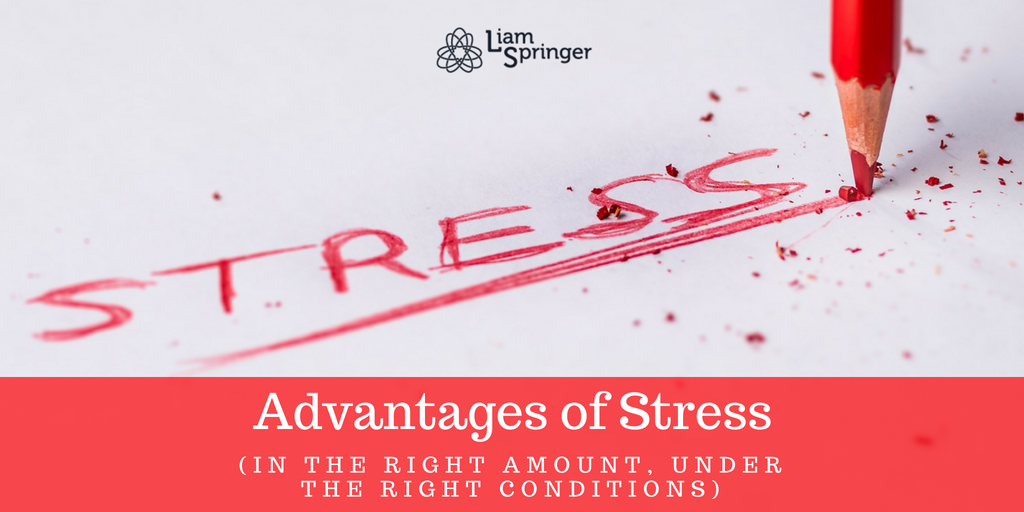You often hear about the negative effects of stress. But it is important to understand how stress can be beneficial, too. There are both good and bad types of stress. Any plan for increasing general well-being should be centered around the reduction and management of stress. However, stressful experiences can also be entertaining and enriching. In this post, I explain the advantages of stress and explore questions like, “What is the optimal amount of stress?” and “How much stress is too much?”
What Are the Advantages of Stress?
Stress and Survival
The stress response is the body’s natural response to difficulty. It’s activated any time you encounter a challenge that’s not easily overcome. In response to acute stress, your body releases adrenaline and taps into energy reserves needed to help you overcome a dangerous threat or difficult hurdle. This is a good thing, right? It’s necessary for survival.
Once Stress Is Overcome, Healing Begins
If stress can be overcome quickly, the body will then relax and begin restoring the energy reserves that were used up during the stressed state. Then, once the body is re-energized, the immune system will repair any damaged tissues. Thus the body regains its pre-stress, functional state. But the adaptive response to stress doesn’t stop there! Once the body is fully restored, there will be an overcompensation characterized by an over-adjustment of energy reserves and tissue function. The body overcompensates in this way so that—in the future—it will be able to meet a similar challenge without undergoing the stress response. This adaptive response to acute stress is one of the ways in which the right exercise program will help you grow stronger and healthier. When a challenge stimulates development in a way that improves the body’s ability to engage the physical demands of life, it has a positive conditioning influence.
With the right exercise program, you can leverage the stress response to your advantage, using it to help you grow stronger and healthier.
Enriching vs. Degrading Events
The sort of stress that stimulates development toward improved resistance to future challenges is what I refer to as an enriching event. The type of stress that leads to impairment of the body’s resistance, on the other hand, is what I call a degrading event. Four important factors that determine whether any given challenge will be enriching vs. degrading are:
- The context of the event
- The quality of its developmental stimulus
- The preparedness of the individual beforehand
- The resources available for adaptation following the event
For more info, read my previous post on Environmental Enrichment and the Power of Success.
What Is the Optimal Amount of Stress?
Evaluating the ideal balance of challenge in any individual’s body is a very complex process. However, you can determine when the level of stress or challenge needs to be modified by looking at some basic physiologic markers as well as the person’s quality of life. There is definitely an amount of stress that is too much, even in a very fit individual. Any stress that leads to sustained production of high levels of cortisol will likely be detrimental. So, you are really looking for a “sweet spot” regarding stress. When using your desired experience of life as a guide for how you spend your stress allowance, you must be aware that in order to change you must adapt. So while challenge is required to stimulate that adaptation, we must have some expendable resources to both meet the challenge and recover in a way that does not cause degeneration. It’s a bit like Goldilocks and the Three Bears—you want the amount of stress that is “just right” for you. Learn about the five categories of stress.
According to Hans Selye, the scientist who did the greatest work in understanding the body’s reaction to stress, “Stress is the spice of life.”
How Much Stress Is Too Much?
If you have a high level of stress in your life at all times, your defense mechanisms will be over-utilized. In this exhausted state, your body will not be able to produce cortisol in sufficient quantities. So any stress will become overwhelming in short order. The most important thing is to take an honest inventory of your day-to-day challenges and the signs that show whether or not your body is meeting them. This includes measuring the quality of every aspect of your health and well-being. Bringing increased challenge into your life, even a positive change, will not produce positive results if your body, mind, or spirit are already showing signs of degenerative compromise. How you feel and function in all aspects of life are signs of your total stress load.
Some level of stress is a part of everyday life, helping you become better equipped to handle future challenges. For more info on how you can leverage the good type of stress, stay tuned for my upcoming post, which will focus on using exercise to harness the power of stress. Plus, check out my previous post for tips on how to deal with stress in the modern world.
For more insights on the latest topics in health and nutrition, sign up for my monthly newsletter. Want to try a new exercise method that’s great for pain management, strength and stability, and flexibility? Go to BTMAStudios.com to learn about the ELDOATM method. Or visit Yoga Source to sign up for classes now.







